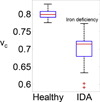Red blood cell population dynamics
- PMID: 25676371
- PMCID: PMC4717490
- DOI: 10.1016/j.cll.2014.10.002
Red blood cell population dynamics
Abstract
Hematology analyzers provide a static snapshot of the circulating population of red blood cells (RBCs). The RBC population is rapidly changing, with more than 2 million RBCs turning over every second in the typical healthy adult. The static snapshot provided by the complete blood count does not capture many of the dynamic aspects of this population, such as the rate of RBC maturation and the rate of RBC turnover. By integrating basic science with hematology analyzer measurements, it is possible to estimate the rates of these dynamic processes, yielding new insights into human physiology, with potential diagnostic application.
Keywords: Diagnostic applications; Mathematical modeling; Personalized medicine; Predictive medicine; RBC life span; RBC turnover; Red blood cell population dynamics; Single-RBC measurements.
Copyright © 2015 Elsevier Inc. All rights reserved.
Figures








References
-
- Mohandas N, Kim YR, Tycko DH, et al. Accurate and independent measurement of volume and hemoglobin concentration of individual red-cells by laser-light scattering. Blood. 1986;68:506–513. - PubMed
-
- Donofrio G, Chirillo R, Zini G, et al. Simultaneous measurement of reticulocyte and red blood cell indices in healthy subjects and patients with microcytic and macrocytic anemia. Blood. 1995;85:818–823. - PubMed
-
- Donofrio G, Zini G, Tommasi M, et al. Automated measurement of total and immature reticulocytes, nucleated red blood cells and apoptotic cells in peripheral blood and bone marrow. Blood. 1996;88:3182.
-
- Liesveld JL, Rowe JM, Lichtman MA. Variability of the erythropoietic response in autoimmune hemolytic anemia–analysis of 109 cases. Blood. 1987;69:820–826. - PubMed
-
- Bain BJ. Leukaemia diagnosis. 3rd edition. Malden (MA): Blackwell; 2003.
Publication types
MeSH terms
Grants and funding
LinkOut - more resources
Full Text Sources
Other Literature Sources

